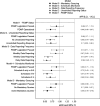Features of prescription drug monitoring programs associated with reduced rates of prescription opioid-related poisonings
- PMID: 29402676
- PMCID: PMC5854200
- DOI: 10.1016/j.drugalcdep.2017.12.002
Features of prescription drug monitoring programs associated with reduced rates of prescription opioid-related poisonings
Abstract
Background: The United States is in the midst of an opioid epidemic. In addition to other system-level interventions, all states have responded during the crisis by implementing prescription drug monitoring programs (PDMPs). This study examines associations between specific administrative features of PDMPs and changes in the risk of prescription opioid-related poisoning (RxORP) over time.
Methods: This longitudinal, observational study utilized a 'natural experiment' design to assess associations between PDMP features and risk of RxORP in a nationally-representative population of privately-insured adults from 2004 to 2014. Administrative health claims data were used to identify inpatient hospital admissions and emergency department visits related to RxORP. Generalized estimating equation Poisson regression models were used to examine associations between specific PDMP features and changes in relative risk (RR) of RxORP over time.
Results: In adjusted analyses, states without PDMPs experienced an average annual increase in the rate of RxORP of 9.51% over the study period, while states with operational PDMPs experienced an average annual increase of 3.17%. The increase in RR of RxORP over time in states with operational PDMPs was significantly less than increases in states without PDMPs. States with specific features, including those that monitored more schedules or required more frequent data reporting, experienced stronger protective effects on the RR of RxORP over time.
Conclusion: This study examined associations between specific PDMP features and RxORP rates in a nationally-representative population of privately-insured adults. Results of this study may be used as empirical evidence to guide PDMP best practices.
Keywords: Evaluation; Opioid; Poisoning; Policy; Prescription drug monitoring program.
Copyright © 2018 Elsevier B.V. All rights reserved.
Conflict of interest statement
The authors have no relevant conflicts of interest to disclose.
Figures



References
-
- Ashburn MA. The evolution of prescription drug monitoring programs. Pharmacoepidemiol. Drug Saf. 2016;25:852–853. - PubMed
-
- Centers for Disease Control and Prevention. Vital signs: Overdoses of prescription opioid pain relievers - United States, 1999–2008. Morb. Mortal. Wkly. Rep. 2011;60:1487–1492. - PubMed
-
- Centers for Disease Control and Prevention. Morb. Mortal. Wkly. Rep. Centers for Disease Control and Prevention; Atlanta, GA: 2012. CDC Grand Rounds: Prescription Drug Overdoses — a U.S. Epidemic. - PubMed
Publication types
MeSH terms
Substances
Grants and funding
LinkOut - more resources
Full Text Sources
Other Literature Sources
Medical

